Rhythm and Blues
Rhythm and Blues is a descriptive term that has never had a clear single meaning. In it's
broadest sense, R&B denotes black pop music. However, as black pop music changes, it
has become a term that is often defined by whatever black musical style it is attached to
at a given point in time, rather than the other way around. In the beginning it was a
renaming of "race" music, which later gave way to soul, funk, disco and simply
"black" styles. Small rhythm and blues combos revved up Tin Pan Alley pop tunes
with rhythms derived from swing jazz and vocals reflecting the blues. They linked the big
band jump blues of the Forties with early rock and roll. Early rock and roll hits were
often covers by white singers of R&B hits, like Elvis Presley's version of Roy Brown's
"Good Rockin' Tonight" or Bill Haley and His Comets cleaned-up take on Big Joe
Turner's "Shake, Rattle and Roll."
Jump Blues
Jump blues is an up-tempo, jazz tinged style of blues, usually played by small
groups, usually featuring a vocalist in front of a large, horn - driven orchestra with
less reliance on guitar work than other styles. Jump blues evolved from the music of big
bands such as those of Lionel Hampton and Lucky Millender. These bands of the early 1940s
produced musicians such as Louis Jordan, Jack McVea, Earl Bostic, and Arnett Cobb. As this
urban, jazz-based music became more popular, both bluesmen and jazz musicians who wanted
to "play for the people" began favoring a heavy, insistent beat. It was
popular in the 1940s and was a precursor of rhythm and blues and rock and roll.
The genesis of R&B is also linked to the stablishment of independent labels record labels such as those below:
 Aladdin Records The Aladdin Story |
 Apollo_Records The Apollo Story |
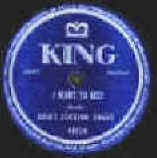 King_Records The King Story |
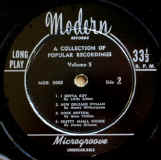 Modern_Records The Modern Story |
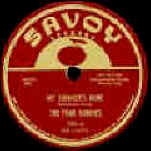 Savoy_Records |
With the ending of the Swing Era the big bands broke into smaller units, jazz and blues going their separate ways to bebop units and dance house R&B "jump blues" bands that played music with a big dance beat and broad appeal. The jump bands began as smaller versions of the swing bands, consisting of a rhythm section and a couple horns that played hard driving riffs and solos over blues progressions, and a boogie derived bass and beat.The overall rhythm accented the backbeats. The featured soloists were usually sax players that who abandoned the finesse of jazz for a wailing sax that matched the energy of the music.Count Basie and Lionel Hampton bands were important bridges between swing and R&B. Basie's 1937 "One O'Clock Jump" and Hampton's 1942 "Flying Home" were signs of things to come. Roy Milton's "R.M. Blues and Joe Liggin's "The Honeydripper" released in 1945, both sold a million copies, signally a re-vitalized "race" and a white audience for this music. Other important records were Roy Brown's 1947 "Good Rockin' Tonight," The Hucklebuck" by a number of artists and Jimmy Liggins' 1950 "The Hucklebuck."
Bridges from swing to rhythm and blues |
Count Basie and Lionel Hampton bands were important bridges between swing and R&B. Basie's 1937 "One O'Clock Jump" and Hampton's 1942 "Flying Home" were signs of things to come.
Blues Shouters
Blues shouters developed their raucous style in order to be heard above the big bands of
the'30s and '40s. Even in the country blues style that preceded them "shouting"
was a way of expressing deep emotion. This raspy, strident vocal style matched in
intensity the big band style. Representatives of the shouter tradition included Big Joe
Turner, Wynonie Harris, and Roy Brown.
Instrumentalists, especially saxophones, played a promenient role in post-war rhythm and blues.
The Honkers |
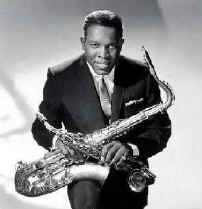 King Curtis |
 Ben "Bullmoose" Jackson |
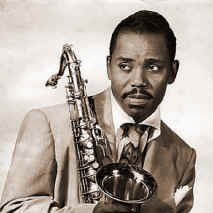 Willis "Gatortail" Jackson |
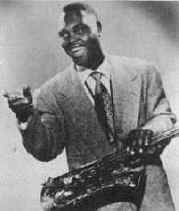 Big Jay McNeeley |
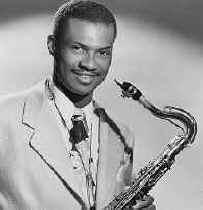 Wild Bill Moore |
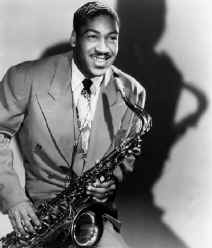 Hal Singer |
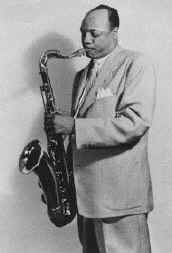 Sam "The Man" Taylor |
 Eddie "Cleanhead" Vinson |
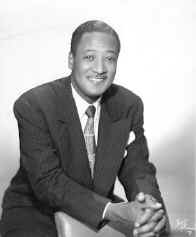 Paul Williams |
King Curtis was inducted into the Rock and Roll Hall of Fame in 2002
The Guitarists |
|
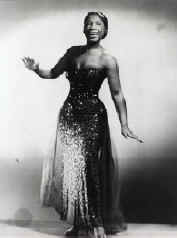 LaVern Baker Inducted into Rock Hall in 1991 |
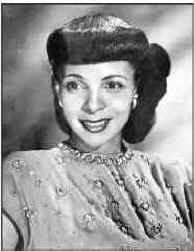 Hadda Brooks |
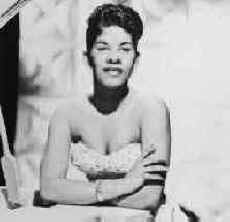 Ruth Brown Inducted into the Rock Hall in 1993 |
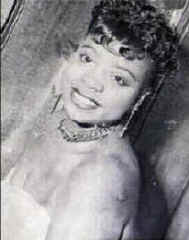 Vanetta Dillard |
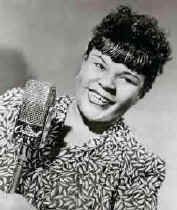 Julia Lee |
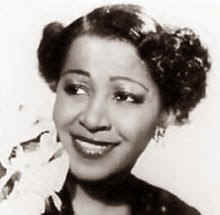 Nellie Lutcher |
 Mabel "Big Maybelle" Smith |
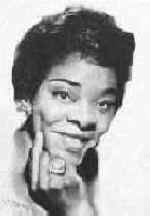 Dinah Washington Inducted into the Rock Hall in 1992 |
|
The decline of the blues shouters coincided with the rise of the male harmony groups.
Doo Wop |